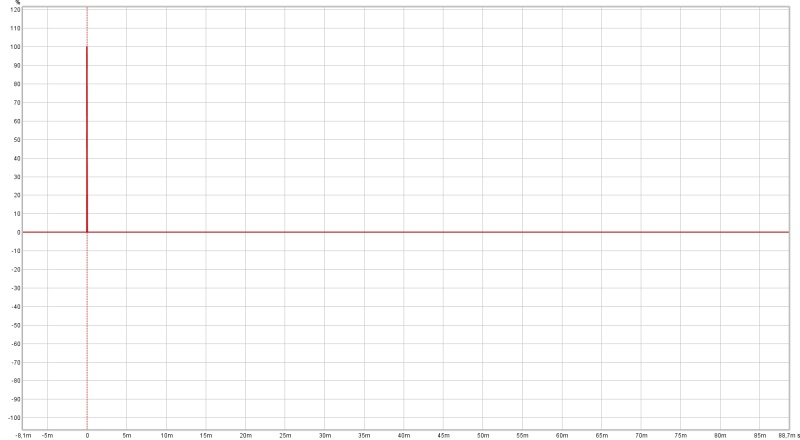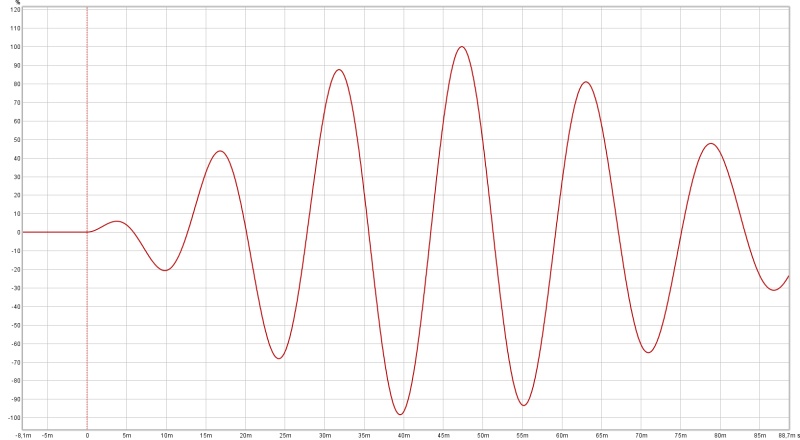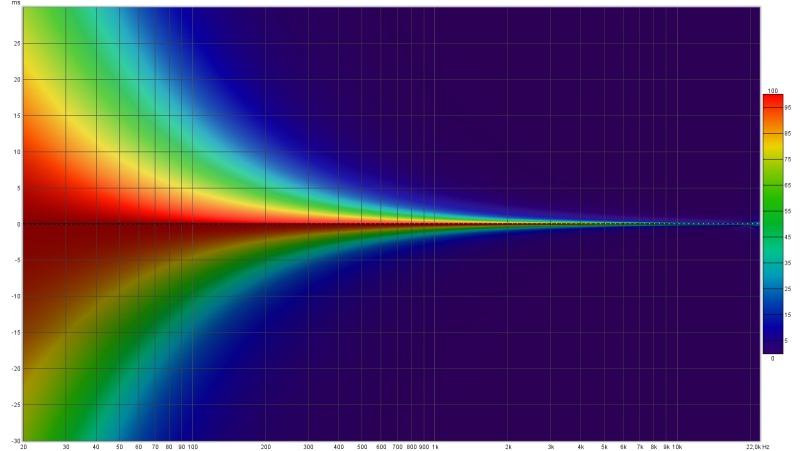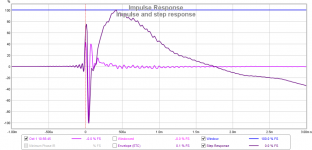"and space"? How does the ear, which is fixed in space, do that exactly?
Two ears.
I've been trying out my waveguided tweeters on top with the m8n woofers run up to 2000 hz. The tweeters are pointed off axis. Increasing the directivity is a huge improvement. I might even stick with the 8" woofer, even though it doesn't quite match the dispersion of the tweeter as well.
Makes me wonder though how cars manage to sound good in such a small space. I'm guessing they use the windshield and interior almost as a waveguide that directs the sound but without the sharp edges or flat surfaces that cause problems.
Data point:
I went to the quite large Toronto HiFi show today. Saw (and in some cases heard too) maybe 70 speaker models almost all demonstrated without grill cloths. Some very very expensive and complex. Some very good*.
I'd guess fewer than 10 models had anything suggesting fussing over diffraction and some (maybe most) of those were probably just coincidentally part of the box aesthetics.
B.
*OK, after hearing the Martin Logan 300 Hz xover ESLs, everything else just sounded like cone drivers in a box, some a bit better than others
I'm surprised. Its not that hard to use rounded shapes maybe made of plastic to save money.
When listening to square boxes, sounds seem all to have the same size. A small speaker, everything sounds small. A big speaker, everything sounds big. Is this due to diffraction?
Yes I think diffraction is one way that we localize and identify sounds, a little bit like sonar but not as advanced. Also internal box noise and panel resonances are things that contribute to a "box" sound.
I think semantics could be getting in the way here. For example we may perceive direction, pressure and timing. This may allude to the events that led up to this but technically it is still an assumption.Afaik the brain makes sense of frequency response variations in both time and space and this affects imaging and coloration.
Just listened to monophonic jazz recordings from 1950s...
In my opinion, listening to mono music (or pink noise?) with the stereo system is a good test for audibility of diffractions and room reflections - and symmetry of them.Tthe monophonic image shoud be narrow and coherent through spectrum, even if the listener moves her head.
In my opinion, listening to mono music (or pink noise?) with the stereo system is a good test for audibility of diffractions and room reflections - and symmetry of them.Tthe monophonic image shoud be narrow and coherent through spectrum, even if the listener moves her head.
I think you're talking about the difference between a minimum phase system and a linear phase system ?
I took these grabs from 'delay alignment a survey' pdf I found online.
Thanks for the graphs !
I've looked at similar wavelets for minimum and linear phase.
I can't say I have it completely sorted out it my mind, but i currently think both minimum and linear phase alignments are still about the time alignment of initial rise times, and not peak energy.
So, for the minimum wavelet skewing, my take is that we are seeing group delay's effect on initial rise relationships.
I think that is what the three overlayed sine waves are showing on what you posted.
I don't think peak energy has anything to do with relative timing, or rather relative phase.
That's why the gammaphone plots that were posted seem off to me...
Last edited:
Hey Mark,
Create a Dirac pulse in RePhase and import it in REW, on the IR tab it will look like a single peak.

Next go to the filtered IR tab and choose some different filters, like 63 Hz, at 1/3th. Switch back each time to the IR tab to see the wave shape at that point, it will show the initial rise times are in sync.
Example from a filtered 63 Hz signal:

Turn off all filters and create a wavelet and it will show this:

Thanks Wesayso,
Yes, I have done that exact exercise several times. It was your help a few years back that led me to see this
I've found a lot of strong evidence for using initial rise time for phase alignment.
For example...Charlie Hughes at Excelsior....good clear presentations.
Here's an example for anyone following along...http://www.excelsior-audio.com/Publ..._Alignment_with_Full-Range_Systems,_rev02.pdf
You sure got that backwards. True, not hard and not terribly costly for these often very expensive speakers....I'm surprised. Its not that hard to use rounded shapes maybe made of plastic to save money.
What the overwhelming majority of speaker manufacturers at the show are saying they don't think this diffraction goblin is very frightening.
B.
I've been thinking I may have made a mistake in pointing out diffraction doesn't matter for spatial localization and what does matter is the difference between the two speakers (which in any case, may well be measurable right from the factory, as anybody who has measured their speakers separately can tell you, than bothering with the diffraction treatment).
Now I am thinking that diffraction might matter if you are listing to musicians who are walking around. Or maybe not.
B.
Now I am thinking that diffraction might matter if you are listing to musicians who are walking around. Or maybe not.
B.
Not surprising. It does not take long in the speaker business to realize that speakers are designed first for appearance and cost and then somewhere down the line performance comes into the mix.What the overwhelming majority of speaker manufacturers at the show are saying they don't think this diffraction goblin is very frightening.
B.
I've been thinking I may have made a mistake in pointing out diffraction doesn't matter for spatial localization and what does matter is the difference between the two speakers...
Now I am thinking that diffraction might matter if you are listing to musicians who are walking around. Or maybe not.
B.
Why walking around? What difference would that make? If they stop walking around the image goes away!?
Why standing still? How does diffraction affect localization when stationary?Not surprising. It does not take long in the speaker business to realize that speakers are designed first for appearance and cost and then somewhere down the line performance comes into the mix.
Why walking around? What difference would that make? If they stop walking around the image goes away!?
As far a exotic speakers at a show, I don't think carpentry cost is the biggest issue nor do I think square corners are the ne plus ultra of good looks (actually, they are the least distinctive thing you can do). Seems to me that the industry "vote" about diffraction is reliable testimony about how the engineers dismiss diffraction.
B.
Last edited:
Two ears.
I was thinking that might be what you meant. To me, two ears are "spaced", not "spatial" or "in space" as the spacing is fixed. Just terminology I guess, but accuracy of terminology is pretty important in discussions like this. We can't have a reasonable discussion when the terms mean different things to different people.
Why standing still? How does that affect localization?
B.
It doesn't, that's my point. You seem to be claiming that it does. Or am I missing something.
Would it be possible to investigate these virtual image sources by a microphone placed near to baffle edge line as shown in the attached photo? If yes, what is the interpretation of the plot shown, measured this way. Thank you.
I agree with dr. Geddes here (see post #398), very difficult to measure in real life. But I think you can get some insight into the problem if you:
1. Measure the speaker on axis as is
2. Apply diffraction control to the baffle (felt seems to be easiest) and measure with the speaker and mic at exactly the same positions as before
3. In measuring program subtract measurement #2 from measurement #1. As a result, everything that is not a diffracted signal should cancel out, including room reflections.
Now, those who have more experience with measuring speakers, please chime in and correct me if I missed something important here. I uploaded a measurement in one of my previous posts that shows what I got using this method.
And, as been said before - steady-state frequency response is not where the real devil hides
I also agree that the differential method works best. I have used it in the past as well, but I look at the differences in the impulse response directly, looking for changes in the > 1ms. region as the most likely diffraction signal. And the cleaner the original impulse response is, which it often is not, the more notable the diffraction effects will be. A smeared impulse response will tend to hide the diffraction and may also mean that diffraction only becomes an audible issue once the impulse response has been made compact.
The problem with this method is that it requires substantial changes to the system for comparison. But comparisons like this are not always feasible. It would be nice to have a way to measure the diffraction of an existing system, but such a thing, while possible, would require substantial laboratory capabilities well beyond what a DIY could do.
The problem with this method is that it requires substantial changes to the system for comparison. But comparisons like this are not always feasible. It would be nice to have a way to measure the diffraction of an existing system, but such a thing, while possible, would require substantial laboratory capabilities well beyond what a DIY could do.
Hi Pavel
I don't ever look at the step response since it is just a LF boosted picture of the impulse response. In the context that I am interested in - diffraction - the LFs don't count. I'll try and look up the impulse response comparisons that I did so you can see what I believe is a significant change.
But looking at just a single impulse response does not allow us to find what is diffraction and what is just ringing. The impulse that you show has a lot of ringing and at some places this ringing seems to grow. True ringing from a resonance should fall monotonically so these points may be diffraction. But it is also possible for two resonances to beat. As I said there are so many possibilities that with a single impulse it is hard to narrow down what is what.
I don't ever look at the step response since it is just a LF boosted picture of the impulse response. In the context that I am interested in - diffraction - the LFs don't count. I'll try and look up the impulse response comparisons that I did so you can see what I believe is a significant change.
But looking at just a single impulse response does not allow us to find what is diffraction and what is just ringing. The impulse that you show has a lot of ringing and at some places this ringing seems to grow. True ringing from a resonance should fall monotonically so these points may be diffraction. But it is also possible for two resonances to beat. As I said there are so many possibilities that with a single impulse it is hard to narrow down what is what.
Hi Earl,
thank you for the reply, I agree. The tweeter used has a sharp resonance tooth at 16.8kHz, this makes T = 59.5us period and this is very close to the period of oscillations in the impulse response. Most probably it is the source of oscillations we can see in the plot.
thank you for the reply, I agree. The tweeter used has a sharp resonance tooth at 16.8kHz, this makes T = 59.5us period and this is very close to the period of oscillations in the impulse response. Most probably it is the source of oscillations we can see in the plot.
I read this entire thread because I was thinking of building a thin wide baffle speaker, about 8" deep, 22" wide, 48" tall with the side edges as 4" radius half rounds. Drivers were to be a centred 10" woof & 10" passive with two 5" mids and on 1" tweet in an MTM configuration vertically aligned but slightly off centre.
I come away from this thread with still not knowing if this would be much better than the standard 12" wide box column this config would normally be found in.
There were not many conclusions to be drawn after all that text.
Or, I am even more obtuse than my wife says I am and I missed it.
I come away from this thread with still not knowing if this would be much better than the standard 12" wide box column this config would normally be found in.
There were not many conclusions to be drawn after all that text.
Or, I am even more obtuse than my wife says I am and I missed it.
There is a member Flaxxer who made a wide, shallow box with large round-overs. The round-overs did not contribute to the internal volume of the box. As such, they could theoretically be made removable, and measurements could be made with and without the large round-overs. That would be an interesting test.
https://www.diyaudio.com/forums/mul...-heil-modular-3-build-thread.html#post5486957
https://www.diyaudio.com/forums/mul...-heil-modular-3-build-thread.html#post5486957
I wouldn't expect many. A flat baffle is within the realms of what can work. There isn't necessarily an ideal case.There were not many conclusions to be drawn
I can tell you that a wide baffle with large roundover is something that can work well. It can work very well in fact. I don't think the shallow cabinet depth is as relevant or critical, your outer cabinet doesn't have to resemble the inner.
One must keep in mind that diffraction is likely to be a secondary effect in that until you have a very compact and clean impulse response before the diffraction will be an issue. Diffraction may not even be audible on a compromised design as it will be masked by the other errors in the system. However, once you reach a very clean impulse response, then diffraction reduction is likely to be a small improvement. It's never going to be a "night and day" sort of thing, but for someone seeking the best possible design, it has to be a consideration.
- Status
- This old topic is closed. If you want to reopen this topic, contact a moderator using the "Report Post" button.
- Home
- Loudspeakers
- Multi-Way
- Baffle Diffraction
